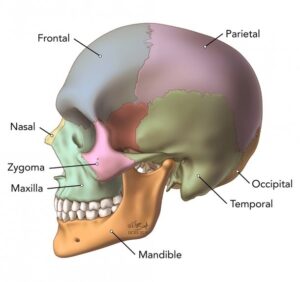What is Nasal Release Technique?
Nasal Release Technique is a special method that helps adjust the bones in your head by working through your nose. This unique approach was created by Dr. J. R. Stober from Portland. It involves a clever tool with a small, soft balloon that’s inserted into your nasal passages. When this balloon is inflated, it gently pushes on the bones inside your nose, especially the sphenoid bone. This action helps realign the sutures in your skull, where the bones meet. The main goal here is to relieve any pressure that may have built up in your skull by fixing these sutures.

The bones and sutures of the skull
Different Names for the Same Technique
This technique has a few different names. Some people call it the Endonasal Technique while others say Cranial Facial Release. You may also hear it referred to as Nasal Cranial Release, Bilateral Nasal Specific Technique, Functional Cranial Release, or Neurocranial ReStructuring Nasal Specific Technique. But don’t get confused – all these names describe the exact same procedure.
Why Timely Treatment Matters
The Nasal Release Technique goes beyond simple adjustments. Untreated concussions can lead to various debilitating symptoms, increased pain, and a longer recovery process. This therapy holds particular significance for athletes, military personnel, and individuals in professions vulnerable to head injuries. Prompt intervention with this can be a game-changer.
Understanding Nasal Release Technique
Our bodies are finely tuned systems always seeking balance. When concussions or birth traumas occur, they can disrupt the alignment of the skull’s bones. This misalignment can result in poor posture, breathing difficulties, pain, and even depression. This Technique realigns these bones, optimizing neurotransmitter activity throughout the Central Nervous System.
What to Expect
Nasal Release Technique is a gentle and non-invasive procedure. It involves a finger cot attached to a blood pressure bulb, which is carefully inserted into the nasal passages. Lubrication ensures your comfort. As the bulb inflates the cot, you may feel gentle pressure in the nose and inside the head. This process is repeated in different nasal sections for balance and maximum effectiveness.
Indications and Symptoms
Nasal Release Technique has shown promise in addressing a range of conditions, including:
- Concussions and head injuries
- Headaches, migraines, and head pressure
- Fatigue, fibromyalgia, and chronic pain
- Muscle spasms, neck, and shoulder pain
- Poor concentration and focus
- PTSD
- Sinusitis, sleep apnea, snoring, and breathing disorders
- Tinnitus (ringing in the ears)
- Traumatic Brain Injury
- TMJ (mouth, head, and jaw pains)
- Vertigo and balance problems
- Whiplash Syndrome
Contraindications and Possible Side Effects
As with any medical procedure, there are contraindications and potential side effects to consider. Patients with bleeding disorders or those taking anticoagulant medications should exercise caution. Those with prior nasal or facial bone surgery, particularly involving turbinates, may not be suitable candidates. In rare cases, asthma attacks have been reported, so asthma patients should have inhalers on hand. Our practitioners conduct thorough medical history checks to identify contraindications.
Possible side effects include nosebleeds, minor soreness, tenderness in nasal passages, tingling in maxillary incisors, gum soreness, and occasional headaches. Temporary throat irritation due to increased sinus drainage may occur. Rest assured, our therapists prioritize your comfort and well-being throughout the treatment process.
For further inquiries or to schedule a consultation with our experienced practitioner in West Des Moines Iowa, Matthew Wilson DC, FIACA, please do not hesitate to contact us.
If you are out of the local area you can find a practitioner here.



